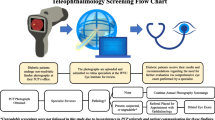Abstract
Introduction
Teleophthalmology for diabetic retinopathy seems to be a cost-effective, accurate, and reliable method for screening for diabetic retinopathy.
Aims
To study the cost-effectiveness of a novel telemedicine-based digital retinal imaging teleophthalmology performed by a locally trained nurse compared to conventional ophthalmologic fundus examination of diabetic patients for early diagnosis of diabetic retinopathy.
Materials and methods
We compared the cost of evaluation of diabetic retinopathy in a total of 3090 patients. These were grouped based on the conventional approach of evaluation (n = 1500) and compared with the teleophthalmology (n = 1590) approach. The diabetic patients were examined through teleophthalmology by a trained nurse using the Forbes 3nethra fundal camera, and these fundal images were transferred by iCloud to a specialized retina center.
Results
In total, 18.2% (n = 562) patients were diagnosed with diabetic retinopathy (DR). Of these, 8.7% had mild non-proliferative diabetic retinopathy (NPDR), 4.8% had moderate NPDR, 3.8% had severe NPDR, and 0.9% had PDR. The total cost of conventional telemedicine-based digital retinal imaging was approximately INR 550 which in contrast was less than half to the total cost of conventional dilated fundus examination by an ophthalmologist (INR 1400).
Conclusion
Our cost analysis indicates that telemedicine-based diabetic retinopathy screening is economical (INR 550 as compared to INR 1400) than conventional retinal examination.
Similar content being viewed by others
References
Li JO, Liu H, Ting DSJ, Jeon S, Chan RVP, Kim JE, Sim DA, Thomas PBM, Lin H, Chen Y, Sakomoto T, Loewenstein A, Lam DSC, Pasquale LR, Wong TY, Lam LA, Ting DSW. Digital technology, tele-medicine and artificial intelligence in ophthalmology: a global perspective. Prog Retin Eye Res. 2020;6:100900. https://doi.org/10.1016/j.preteyeres.2020.100900 (Epub ahead of print).
Rani PK, Peguda HK, Chandrashekher M, Swarna S, Jonnadula GB, James J, Shinde L, Bharadwaj SR. Capacity building for diabetic retinopathy screening by optometrists in India: model description and pilot results. Indian J Ophthalmol. 2021;69(3):655–9. https://doi.org/10.4103/ijo.IJO_1944_20.
Carl HP, Ehsan R, Abtin S, Jay LF. Telemedicine in ophtahlmology: numerous factors are driving a transition to remote screening. Retina Today.2017 Apr; 55–58
Morse AR. Telemedicine in ophthalmology: promise and pitfalls. American Academy of Ophthalmology. Elsevier Inc., Ophthalmology. 2014 Apr;121(4)
Sosale AR. Screening for diabetic retinopathy—is the use of artificial intelligence and cost-effective fundus imaging the answer? Int J Diabetes Dev Ctries. 2019;39:1–3. https://doi.org/10.1007/s13410-019-00729-y.
Sosale B, Sosale AR, Mohan AR, Kumar PM, Saboo B, Kandula S. Cardiovascular risk factors, micro and macrovascular complications at diagnosis in patients with young onset T2 diabetes in India: CINDI 2. Indian J Endocrinol Metab. 2016;20:114–8.
Viswanathan V. Diabetic kidney disease and diabetic retinopathy: the ominous duo. Int J Diabetes Dev Ctries. 2020;40:313–4. https://doi.org/10.1007/s13410-020-00867-8.
Xie Y, Nguyen QD, Hamzah H, Lim G, Bellemo V, Gunasekeran DV, Yip MYT, Qi Lee X, Hsu W, Li Lee M, Tan CS, Tym Wong H, Lamoureux EL, Tan GSW, Wong TY, Finkelstein EA, Ting DSW. Artificial intelligence for teleophthalmology-based diabetic retinopathy screening in a national programme: an economic analysis modelling study. Lancet Digit Health. 2020;2(5):e240–9. https://doi.org/10.1016/S2589-7500(20)30060-1 (Epub 2020 Apr 23).
Delgoshaei B, Mobinizadeh M, Mojdekar R, Afzal E, Arabloo J, Mohamadi E. Telemedicine: a systematic review of economic evaluations. Med J Islam Repub Iran. 2017;31:113. https://doi.org/10.14196/mjiri.31.113.
Mohammadpour M, Heidari Z, Mirghorbani M, Hashemi H. Smartphones, tele-ophthalmology, and VISION 2020. Int J Ophthalmol. 2017;10(12):1909–18. https://doi.org/10.18240/ijo.2017.12.19.
Boucher MC, Nguyen MTD, Qian J. Assessment of training outcomes of nurse readers for diabetic retinopathy telescreening: validation study. JMIR Diabetes. 2020;5(2):e17309. https://doi.org/10.2196/17309.
Alhumud A, Al Adel F, Alwazae M, Althaqib G, Almutairi A. Patient satisfaction toward a tele-retinal screening program in endocrinology clinics at a tertiary hospital in Riyadh, Saudi Arabia. Cureus. 2020;12(5):e7986. https://doi.org/10.7759/cureus.7986.
Kalogeropoulos D, Kalogeropoulos C, Stefaniotou M, Neofytou M. The role of tele-ophthalmology in diabetic retinopathy screening. J Optom. 2020;13(4):262–8. https://doi.org/10.1016/j.optom.2019.12.004 (Epub 2020 Jan 14).
Javit JC. Cost-savings associated with detection and treatment off diabetic eye disease. Pharmacoeconomics. 1995;8:33–9.
Bjorvig S, Johansen MA, Fossen K. An economic analysis of telemedicine to evaluate diabetic retinopathy. J Telemed Telecare. 2002;8:32–5.
Raman R, Padmaja RK, Sharma T. The sensitivity and specificity of non-mydriatic digital stereoscopic retinal imaging in detecting diabetic retinopathy. Diabetes Care. 2007;30:1.
Gunasekeran DV, Ting DSW, Tan GSW, Wong TY. Artificial intelligence for diabetic retinopathy screening, prediction and management. CurrOpinOphthalmol. 2020;31(5):357–65. https://doi.org/10.1097/ICU.0000000000000693.
Kanjee R, Dookeran RI, Mathen MK, Stockl FA, Leicht R. Six-year prevalence and incidence of diabetic retinopathy and cost-effectiveness of tele-ophthalmology in Manitoba. Can J Ophthalmol. 2017;52(Suppl 1):S15–8. https://doi.org/10.1016/j.jcjo.2017.09.022.
DeBuc DC. The role of retinal imaging and portable screening devices in tele-ophthalmology applications for diabetic retinopathy management. Curr Diab Rep. 2016;16(12):132. https://doi.org/10.1007/s11892-016-0827-2.
Sabanayagam C, Yip W, Ting DS, Tan G, Wong TY. Ten emerging trends in the epidemiology of diabetic retinopathy. Ophthalmic Epidemiol. 2016;23(4):209–22. https://doi.org/10.1080/09286586.2016.1193618 (Epub 2016 Jun 29).
Dookeran R, Maberley D, Samad A, Chaudhary V, Steering Committee for Tele-Ophthalmology Screening, Canadian Retina Research Network. Evidence-based Canadian guidelines for tele-retina screening for diabetic retinopathy: recommendations from the Canadian Retina Research Network (CR2N) Tele-Retina Steering Committee. Can J Ophthalmol. 2020;55(1 Suppl):14–24. https://doi.org/10.1016/j.jcjo.2020.01.001.
Sreelatha OK, Ramesh SV. Teleophthalmology: improving patient outcomes? Clin Ophthalmol. 2016;10(10):285–95. https://doi.org/10.2147/OPTH.S80487.
Brady CJ, Villanti AC, Gupta OP, Graham MG, Sergott RC. Tele-ophthalmology screening for proliferative diabetic retinopathy in urban primary care offices: an economic analysis. Ophthalmic Surg Lasers Imaging Retina. 2014;45(6):556–61. https://doi.org/10.3928/23258160-20141118-11.
Author information
Authors and Affiliations
Corresponding author
Additional information
Publisher's Note
Springer Nature remains neutral with regard to jurisdictional claims in published maps and institutional affiliations.
Rights and permissions
About this article
Cite this article
Chawla, S., Chawla, A., Chawla, R. et al. Trained nurse–operated teleophthalmology screening approach as a cost-effective tool for diabetic retinopathy. Int J Diabetes Dev Ctries 42, 747–750 (2022). https://doi.org/10.1007/s13410-021-01037-0
Received:
Accepted:
Published:
Issue Date:
DOI: https://doi.org/10.1007/s13410-021-01037-0




